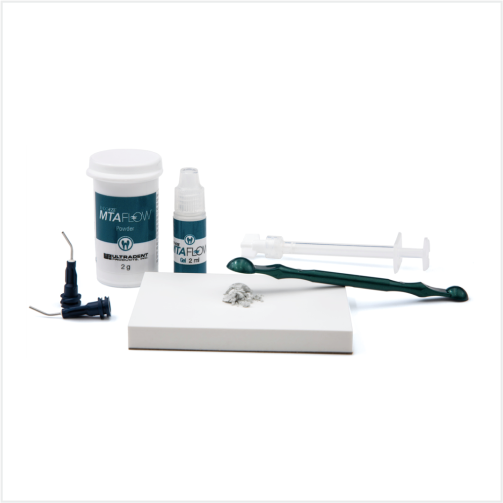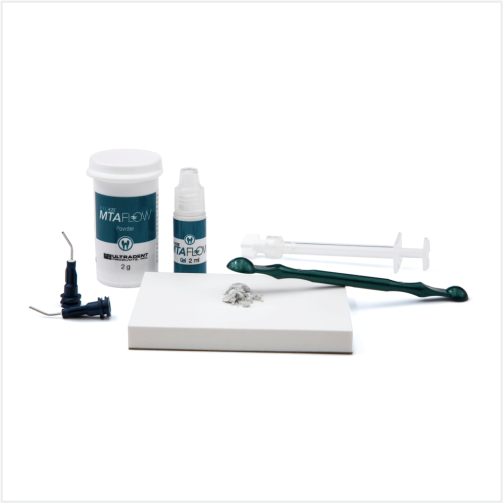[vc_row][vc_column width=”1/4″][/vc_column][vc_column width=”1/2″][us_post_title align=”center” css=”%7B%22default%22%3A%7B%22color%22%3A%22%23ffffff%22%2C%22background-color%22%3A%22%23051D63%22%2C%22border-radius%22%3A%2230px%22%7D%7D”][us_image image=”12670″ size=”medium” align=”center” el_class=”borderr”][/vc_column][vc_column width=”1/4″][/vc_column][/vc_row][vc_row css=”%7B%22default%22%3A%7B%22margin-top%22%3A%22-50px%22%7D%7D”][vc_column][vc_column_text]
سمانهای Mineral Trioxide Aggregate که با نام تجاری MTA شناخته می شوند. مهمترین ویژگیهای کاربردی MTA می توان به خاصیت آبدوستی، زیست سازگاری، و خاصیت ضد باکتریایی آن اشاره کرد. این ماده ترکیبی است از تریکلسیمسیلیکات، تریکلسیم اکسید، تری کلسیم آلومینات، اکسیدسیلیکات وبعضی اکسیدهای دیگر. مجموعه این ویژگی ها باعث شده MTA به عنوان یک ماده مهم در حوزه اندودنتیکس شناخته شود. سمان های MTA در پالپاتومی، اپکسیفیکاسیون (عملی که برای تحریک رشد ریشه یا بسته شدن نوک ریشه انجام میشود) و پوشش پالپ استفاده کرد. باز بودن نوک ریشه اغلب در دندانهایی دیده میشود که هنوز به طور کامل رشد نکرده اند یا ریشه آنها در اثر فرایندی به نام باز جذب ریشه فرسایش یافته و از بین رفته است به همین دلیل این ماده در پالکتومی و پالپتومی در بخش دندانپزشکی کودکان کاربرد بسیار زیادی دارد.
ویژگیهای مطلوب سمان MTA این است که از لحاظ فیزیکی ـ شیمیایی ماده در برابر خون و رطوبت سفت میشود . دارای تطابق مارژینال خیلی نامناسب بوده، حلالیت پائینی دارد و غیرقابل جذب است. هنگام سفت شدن در کنار یونهای کلسیم و مایعات بافتی، یک لایهی واکنشی در کنار عاج از لحاظ ساختمانی مشابه هیدروکسی آپاتیت ایجاد میشود. دارای pH برابر 12.5دارد و از این جهت بسیاری از خواص بیولوژی و بافتشناسی آن قابل قیاس با هیدروکسید کلسیم است. pH بالای آن باعث جذب عوامل رشد از عاج مجاور شده که میتوانند مسئول ایجاد سد عاجی شوند. در مجموع ریز نشت کمی دارد و کمتر سمی بوده و اثر باکتریواستاتیک بهتری دارد. بررسیهای بافتشناسی نشانداده که MTA باعث ایجاد سمان ورسوب استخوان با حداقل پاسخ التهابی است.
این سمان یک بیوسرامیک ترمیم اندو با قدرت ترمیمی بالا میباشد که از دو جز پودر حاوی فازهای مختلف سیلیکات کلسیم، سیلیکات آلومینیوم و دی اکسید زیرکونیوم و جز مایع شامل آب استریل، کلسیم کلراید و ماده قوام دهنده طبیعی تشکیل شده است. یون های کلسیم آزاد شده از سمان باعث تشکیل پل عاجی در مواد استفاده به عنوان پوشاننده پالپ و بهبود ترمیم بیولوژیکی و القای بازسازی بافت سمنتوم و ریشه میشود. این سمان به منظور کاربرد در شرایط مرطوب طراحی شده است که با جذب آب به فرم ژل درآمده و سپس سخت میشود.
در مجموع سمان MTA در موارد زیر کاربرد دارد:
- ماده پرکننده انتهای ریشه پس از جراحی اندودنتیک
- ماده پوشاننده مستقیم پالپ و در درمان های پالپوتومی
- ماده پوشاننده پالپ ریشه ها هنگام درمانهای اپکسیفیکاسیون
- ماده ترمیم پرفوراسیون های ناشی از تحلیل داخلی
[/vc_column_text][/vc_column][/vc_row]



